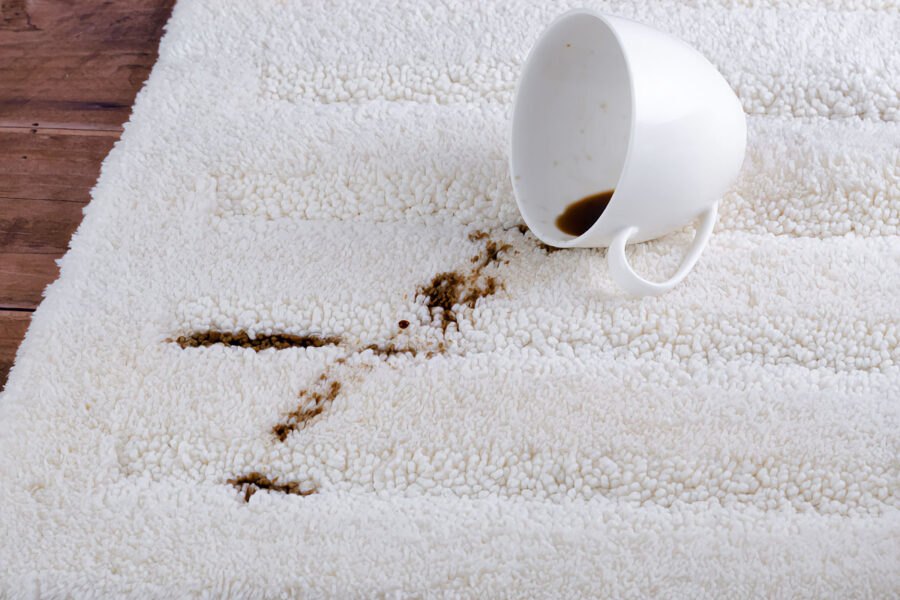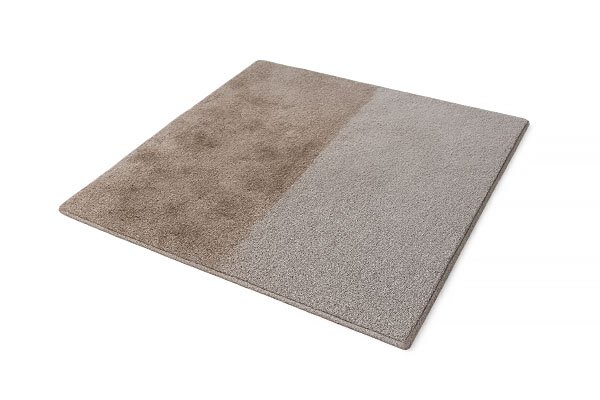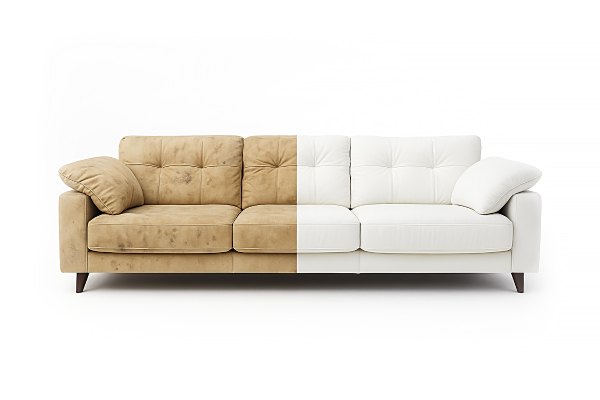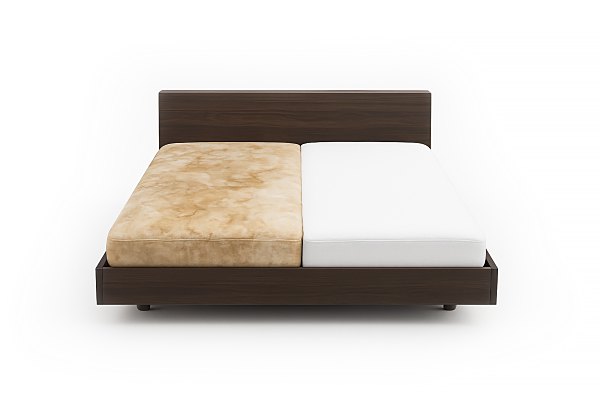Coffee spills on carpet can transform a perfect morning into a stressful situation. The rich, dark liquid seems to find its way onto the most pristine carpets at the worst possible moments. Whether it’s that first cup of the day or an afternoon pick-me-up, coffee accidents happen to everyone.
The good news is that coffee stains don’t have to become permanent carpet disasters. With the right approach and quick action, most coffee spills can be removed completely. The key lies in understanding how coffee interacts with carpet fibres and knowing which cleaning methods work best for different situations.
Why acting quickly makes all the difference when coffee hits your carpet?
Time becomes the most critical factor when coffee meets carpet fibres. Fresh coffee spills respond dramatically better to cleaning efforts than dried stains. The longer coffee sits on carpet, the deeper it penetrates into the fibres and backing material.
Coffee contains tannins, natural compounds that create its rich colour and distinctive taste. These same tannins act as powerful dyes when they contact carpet fibres. Within minutes of contact, tannins begin bonding with carpet materials, creating chemical bonds that become increasingly difficult to break as time passes.
The science behind coffee staining
Temperature plays a crucial role in how quickly coffee stains set. Hot coffee accelerates the staining process significantly compared to cold coffee. The heat opens carpet fibres, allowing tannins to penetrate deeper into the material structure. This explains why fresh hot coffee creates more challenging stains than iced coffee spills.
Carpet material composition affects staining speed and severity. Natural fibres like wool absorb coffee faster than synthetic materials. However, synthetic carpets can still develop permanent stains if not treated promptly. Understanding carpet type helps determine the most effective cleaning approach.
The pH level of coffee also influences staining potential. Coffee’s acidic nature can alter carpet dyes, particularly in lighter-coloured carpets. This chemical reaction becomes more pronounced over time, making immediate action essential for preventing permanent discolouration.
Moisture content in coffee affects penetration depth. Black coffee penetrates differently than coffee with milk or cream. Added dairy products create additional protein-based stains that require different cleaning approaches. Sugar content also influences how quickly stains set and bond with carpet fibres.
Time windows for successful removal
The first five minutes after a spill offer the best chance for complete stain removal. During this window, coffee remains on the surface and hasn’t fully penetrated carpet fibres. Simple blotting with clean towels often removes fresh spills entirely.
After 15 minutes, coffee begins setting into carpet fibres. Removal becomes more challenging but remains possible with proper cleaning solutions. The stain may require multiple treatment cycles to achieve complete removal.
Once coffee has dried completely, removal becomes significantly more difficult. Set-in stains often require professional cleaning equipment or multiple treatment sessions. Some dried stains may become permanent if left untreated for extended periods.
Environmental factors affect drying time and stain setting. High humidity slows drying but may prevent rapid stain setting. Low humidity accelerates both drying and permanent staining. Room temperature also influences how quickly coffee bonds with carpet materials.
Chemical reactions during staining
Tannin molecules form complex bonds with carpet fibres through oxidation processes. These bonds strengthen over time, making older stains increasingly resistant to removal. Understanding this process helps explain why immediate treatment proves so effective.
Carpet dyes interact with coffee tannins in unpredictable ways. Light-coloured carpets show stains more readily but may respond better to cleaning. Dark carpets hide stains initially but can develop permanent discolouration that becomes visible over time.
The alkaline nature of some cleaning products can set coffee stains permanently if used incorrectly. This explains why cold water and acidic solutions often work better than alkaline cleaners for coffee removal.
Essential household items you’ll need for effective coffee stain removal
Most coffee stain removal can be accomplished using common household items. Having the right supplies readily available ensures quick response when spills occur. These basic materials form the foundation of effective carpet cleaning.
Clean white towels or microfibre cloths serve as the primary tools for blotting and absorbing spilled coffee. White materials prevent colour transfer to the carpet during cleaning. Microfibre cloths offer superior absorption compared to regular towels.
Basic cleaning supplies
Cold water forms the basis of most coffee stain removal methods. Cold temperatures prevent the stain from setting deeper into carpet fibres. Warm or hot water can actually make coffee stains worse by opening fibres and allowing deeper penetration.
Liquid dish soap provides gentle cleaning power without damaging carpet fibres. Choose mild, enzyme-free dish soap for best results. Enzyme-based detergents work better for coffee with milk or cream additions.
White vinegar acts as a natural stain remover and deodoriser. The acidic properties help break down coffee tannins while neutralising odours. Distilled white vinegar works best for carpet cleaning applications.
Paper towels offer convenient disposable absorption for initial spill response. Choose high-quality paper towels that won’t tear or leave residue. Keep multiple rolls available for larger spills that require extensive blotting.
Essential cleaning kit items:
- Clean white towels or microfibre cloths
- Cold water in spray bottles
- Mild liquid dish soap
- White vinegar
- Paper towels
- Clean sponges
The items listed above represent the minimum requirements for effective coffee stain removal. Each item serves a specific purpose in the cleaning process. Having these supplies readily available makes the difference between successful stain removal and permanent carpet damage.
Advanced cleaning materials
Baking soda offers multiple benefits in coffee stain removal. It absorbs moisture, neutralises odours, and provides gentle abrasive action. Baking soda works particularly well on dried or set-in stains.
Spray bottles allow precise application of cleaning solutions. This prevents over-wetting the carpet and helps control the cleaning process. Multiple spray bottles enable quick switching between different cleaning solutions.
Clean sponges provide controlled application of cleaning solutions. Natural sponges work better than synthetic ones for carpet cleaning. Ensure sponges are completely clean before use to avoid introducing new stains.
Hydrogen peroxide serves as a powerful stain remover for stubborn coffee marks. Use only 3% hydrogen peroxide solutions to avoid carpet damage. Test in an inconspicuous area before applying to visible stains.
Storage and organisation tips
Keep all cleaning supplies in a designated container for quick access. A portable cleaning caddy allows immediate response to spills anywhere in the home. Store supplies in a cool, dry location to maintain effectiveness.
Label spray bottles clearly to avoid confusion during emergency cleaning situations. Replace cleaning solutions regularly to ensure maximum effectiveness. Check expiration dates on commercial products and replace as needed.
Pro tip: Keep a dedicated coffee spill kit in your kitchen or living area. Include white towels, spray bottles with cold water, and basic cleaning supplies for immediate response to spills.
Step-by-step method for blotting and treating fresh coffee spills
Immediate action determines the success of coffee stain removal. The blotting technique prevents the spill from spreading while removing as much liquid as possible. Proper blotting technique can eliminate many fresh spills entirely.
Start by grabbing clean white towels or paper towels immediately after the spill occurs. Avoid coloured towels that might transfer dye to the carpet. Work from the outside of the spill toward the centre to prevent spreading.
Proper blotting technique
Press towels firmly onto the spill without rubbing or scrubbing motions. Blotting absorbs liquid while rubbing pushes coffee deeper into carpet fibres. Apply steady pressure for several seconds, then lift the towel straight up.
Replace saturated towels with fresh ones as needed. Continue blotting until towels come away relatively dry. This process may require multiple towels depending on spill size.
Check the carpet backing by lifting a corner if possible. Ensure coffee hasn’t penetrated through to the padding underneath. Spills that reach the padding require more extensive cleaning to prevent odours and mould growth.
Monitor the towels for colour transfer from the carpet. If carpet dyes appear on towels, stop blotting immediately. This indicates the carpet may not be colourfast and requires professional cleaning.
Cold water treatment
Apply cold water sparingly to the remaining stain area. Use a spray bottle for controlled application or dampen a clean cloth. Avoid soaking the carpet, which can cause backing damage and extended drying times.
Blot the water-dampened area with fresh towels. The cold water helps dilute remaining coffee residue while preventing the stain from setting. Repeat the water application and blotting process until no more coffee transfers to the towels.
Allow the area to air dry completely before assessing results. Many fresh spills disappear entirely with prompt blotting and cold water treatment. If staining remains visible after drying, proceed to cleaning solution application.
Place fans near the treated area to accelerate drying. Proper air circulation prevents moisture buildup that can lead to mould or mildew. Avoid walking on the damp area until completely dry.
Assessment and next steps
Examine the treated area under good lighting once completely dry. Some stains may appear gone when wet but become visible after drying. Natural sunlight provides the best assessment conditions.
Document the cleaning process and results for future reference. Note which techniques worked best for specific carpet types. This information proves valuable for future spill incidents.
Pro tip: Place a thick layer of paper towels over the treated area and weigh them down with books. Leave overnight to absorb any remaining moisture and prevent the stain from wicking back to the surface.
Professional carpet cleaning services in Sydney provided by SevenClean
When home cleaning methods fail to remove stubborn coffee stains, professional carpet cleaning services offer advanced solutions. SevenClean provides specialised carpet and rug cleaning services throughout Sydney, using commercial-grade equipment and techniques that surpass household cleaning methods.
SevenClean operates as a comprehensive cleaning service company based in Sydney, offering multiple cleaning solutions for residential and commercial properties. The company specialises in deep cleaning services that restore carpets to their original condition using professional-grade equipment and eco-friendly cleaning solutions.
Carpet and rug cleaning services
SevenClean’s carpet and rug cleaning service employs hot water extraction methods that penetrate deep into carpet fibres. This technique removes embedded coffee stains that household cleaning cannot reach. The process involves pre-treatment of stains, deep steam cleaning, and thorough extraction of cleaning solutions and contaminants.
The company uses specialised stain removal products designed specifically for coffee and other beverage stains. These commercial-grade solutions break down tannin bonds more effectively than household cleaners. Professional technicians assess each stain individually to determine the most appropriate treatment method.
Advanced equipment includes truck-mounted cleaning systems that provide superior suction power. This equipment removes more moisture and cleaning residue than portable units. Faster drying times reduce the risk of mould growth and carpet damage.
Professional cleaning process steps:
- Initial stain assessment and testing
- Pre-treatment with specialised solutions
- Hot water extraction cleaning
- Post-treatment inspection
The systematic approach ensures thorough stain removal while protecting carpet integrity. Each step builds upon the previous one to achieve optimal results. Professional technicians monitor progress throughout the process to adjust techniques as needed.
Comprehensive cleaning services
SevenClean offers multiple cleaning services beyond carpet cleaning, making them a one-stop solution for home maintenance. Their service portfolio includes furniture upholstery cleaning, mattress cleaning, and general house cleaning services.
Furniture upholstery cleaning addresses coffee stains on sofas, chairs, and other fabric furniture. The same professional techniques used for carpets apply to upholstered furniture, with adjustments for different fabric types. This service prevents the need to replace expensive furniture due to staining.
Mattress cleaning services remove coffee stains and odours from bedroom accidents. Professional cleaning extends mattress life while ensuring a hygienic sleeping environment. The process includes stain removal, sanitisation, and deodorisation.
The company’s integrated approach allows customers to address multiple cleaning needs in a single service call. This efficiency saves time and money while ensuring consistent quality across all cleaning services.
SevenClean services
Service benefits and guarantees
SevenClean provides satisfaction guarantees on their cleaning services, including stain removal effectiveness. If coffee stains return after professional cleaning, the company offers re-treatment at no additional cost. This guarantee demonstrates confidence in their cleaning methods and equipment.
Professional cleaning extends carpet life by removing damaging substances that cause fibre deterioration. Regular professional maintenance prevents permanent staining and reduces replacement costs. The investment in professional cleaning often pays for itself through extended carpet lifespan.
Emergency cleaning services accommodate urgent stain removal needs. Coffee spills at important events or before special occasions require immediate professional attention. SevenClean’s rapid response capability prevents permanent staining in critical situations.
Pro tip: Schedule professional carpet cleaning annually, even without visible stains. Regular maintenance removes accumulated soil and prevents coffee stains from setting permanently during future spills.
Homemade cleaning solutions that actually work on stubborn coffee stains
When basic water and blotting methods fail, homemade cleaning solutions provide effective alternatives to commercial products. These solutions use common household ingredients to break down coffee stains without damaging carpet fibres. Proper mixing ratios and application techniques ensure maximum effectiveness.
Natural cleaning solutions often work better than harsh chemicals for coffee stain removal. The acidic nature of coffee responds well to alkaline cleaning solutions that neutralise tannins. Understanding the chemistry behind stain removal helps select the most appropriate homemade solution.
Vinegar-based cleaning solutions
White vinegar mixed with cold water creates an effective coffee stain remover. Mix one part white vinegar with two parts cold water in a spray bottle. The acidic vinegar breaks down coffee tannins while the water dilutes the stain.
Apply the vinegar solution sparingly to the stained area. Allow the solution to sit for five minutes before blotting with clean towels. The vinegar neutralises coffee alkaloids while preventing the stain from setting deeper.
Rinse the treated area with cold water after vinegar application. Blot thoroughly to remove all cleaning residue. Vinegar odour dissipates as the carpet dries, leaving no lingering smell.
Test the vinegar solution in an inconspicuous area first. Some carpet dyes may react with acidic solutions, causing colour changes. Always verify compatibility before treating visible stains.
Baking soda paste treatment
Baking soda mixed with small amounts of water creates a powerful stain-lifting paste. Combine three parts baking soda with one part water to form a thick paste. The alkaline baking soda neutralises acidic coffee while providing gentle abrasive action.
Apply the paste directly to dried coffee stains, covering the entire affected area. Allow the paste to sit for 30 minutes to penetrate the stain. The baking soda absorbs odours while breaking down stain compounds.
Vacuum the dried paste thoroughly, then rinse with cold water. Blot the area dry with clean towels. Multiple applications may be necessary for stubborn stains.
Baking soda paste works particularly well on older, set-in coffee stains. The extended contact time allows deeper penetration into carpet fibres. This method requires patience but often succeeds where other treatments fail.
Dish soap solution formula
Liquid dish soap combined with cold water creates a gentle yet effective cleaning solution. Mix one tablespoon of mild dish soap with two cups of cold water. Avoid using dish soap with added fragrances or colours that might stain the carpet.
Apply the soap solution using a clean cloth or spray bottle. Work the solution into the stain with gentle dabbing motions. The soap breaks down coffee oils while lifting stain particles from carpet fibres.
Rinse thoroughly with cold water to remove all soap residue. Soap left in carpet fibres attracts dirt and can cause rapid re-soiling. Multiple rinses may be necessary to remove all cleaning solution.
Effective homemade solutions:
- Vinegar solution: 1 part vinegar, 2 parts cold water
- Baking soda paste: 3 parts baking soda, 1 part water
- Dish soap mixture: 1 tablespoon soap, 2 cups water
- Hydrogen peroxide solution: 1 part 3% peroxide, 1 part water
These homemade solutions provide cost-effective alternatives to commercial cleaners. Each solution targets different aspects of coffee stains for comprehensive removal. The ingredients are readily available in most households, making immediate treatment possible.
Pro tip: Always test homemade cleaning solutions in an inconspicuous area before applying to visible stains. Document which solutions work best for your specific carpet type for future reference.
Advanced techniques for removing dried and set-in coffee stains
Dried coffee stains require more aggressive treatment methods than fresh spills. Set-in stains have formed chemical bonds with carpet fibres that resist simple cleaning solutions. Advanced techniques combine multiple cleaning methods to break down these stubborn stains.
The key to removing dried coffee stains lies in rehydrating the stain before applying cleaning solutions. Dried stains must be softened to allow cleaning agents to penetrate effectively. This process requires patience and multiple treatment cycles.
Steam treatment method
Steam helps rehydrate dried coffee stains, making them more responsive to cleaning solutions. Use a clothes steamer or steam iron held several inches above the stain. The heat and moisture soften hardened coffee residue without over-wetting the carpet.
Apply steam for 30-60 seconds, then immediately apply cleaning solution while the stain remains soft. The combination of heat and cleaning agents breaks down stain bonds more effectively than cold treatments. Work quickly before the stain dries again.
Follow steam treatment with immediate blotting using clean towels. The softened stain transfers more readily to absorbent materials. Multiple steam and cleaning cycles may be necessary for complete removal.
Ensure adequate ventilation during steam treatment to prevent moisture buildup. Excess humidity can damage carpet backing or promote mould growth. Use fans to accelerate drying after treatment.
Enzyme cleaner application
Enzyme cleaners break down protein-based stains in coffee with milk or cream additions. These biological cleaners digest stain compounds at the molecular level. Purchase enzyme cleaners specifically designed for carpet use.
Apply enzyme cleaner generously to cover the entire stained area. Allow the cleaner to sit for the manufacturer’s recommended time, usually 15-30 minutes. Enzyme action requires time to break down complex stain molecules.
Cover the treated area with plastic wrap to prevent evaporation. This maintains moisture levels necessary for enzyme activity. Remove the plastic and blot the area thoroughly after treatment time expires.
Rinse with cold water to remove enzyme cleaner residue. Some enzyme cleaners continue working after application, potentially causing carpet damage if not removed completely. Multiple rinses ensure complete removal.
Heat and pressure technique
Combining heat and pressure can remove stubborn dried stains that resist other methods. Place a clean white cloth over the stained area, then apply a warm iron for 10-15 seconds. The heat transfers stain particles to the cloth.
Use medium heat settings to avoid carpet damage. Synthetic carpets can melt under excessive heat, causing permanent damage. Test heat tolerance in an inconspicuous area first.
Replace the cloth frequently as it absorbs stain particles. Multiple applications with fresh cloths gradually remove embedded stains. Monitor progress carefully to avoid over-treatment.
Apply cleaning solution between heat treatments for enhanced effectiveness. The combination of chemical and thermal action breaks down resistant stain bonds. Allow cooling between applications to prevent carpet damage.
Advanced stain removal sequence:
- Steam treatment to rehydrate stain
- Apply appropriate cleaning solution
- Allow dwell time for chemical action
- Heat and pressure extraction
- Thorough rinsing and drying
This systematic approach maximises the effectiveness of each treatment step. The sequence builds upon previous treatments to achieve complete stain removal. Professional cleaners often use similar multi-step processes for challenging stains.
Pro tip: For extremely stubborn stains, repeat the entire advanced treatment process after 24 hours. Sometimes multiple treatment cycles are necessary to completely remove set-in coffee stains.
Summary
Coffee spill cleanup requires immediate action and proper technique to prevent permanent carpet staining. The tannins in coffee bond quickly with carpet fibres, making time the most critical factor in successful removal. Fresh spills respond well to simple blotting with cold water, while dried stains require advanced cleaning methods including steam treatment and specialised solutions.
Essential household items like white towels, cold water, vinegar, and baking soda provide effective cleaning power for most coffee stains. Professional services like SevenClean offer advanced equipment and expertise for stubborn stains that resist home treatment methods. Their comprehensive cleaning services extend beyond carpets to include upholstery and mattress cleaning throughout Sydney.
Success in coffee stain removal depends on understanding the science behind staining and applying appropriate techniques for each situation. With proper knowledge and quick response, most coffee spills can be removed completely, preserving carpet appearance and extending its lifespan.





